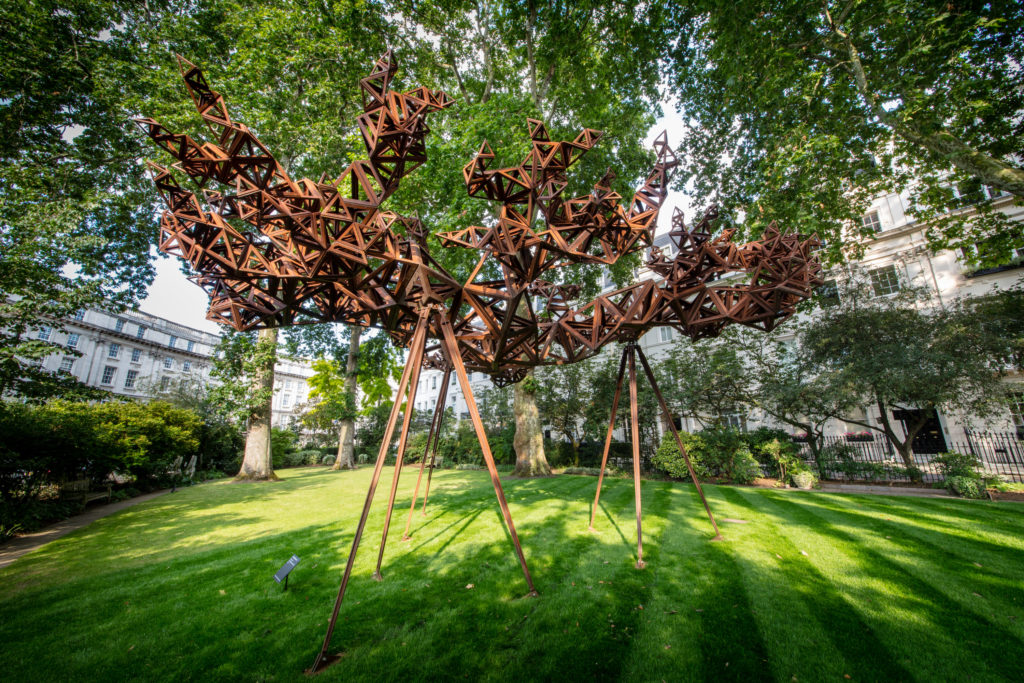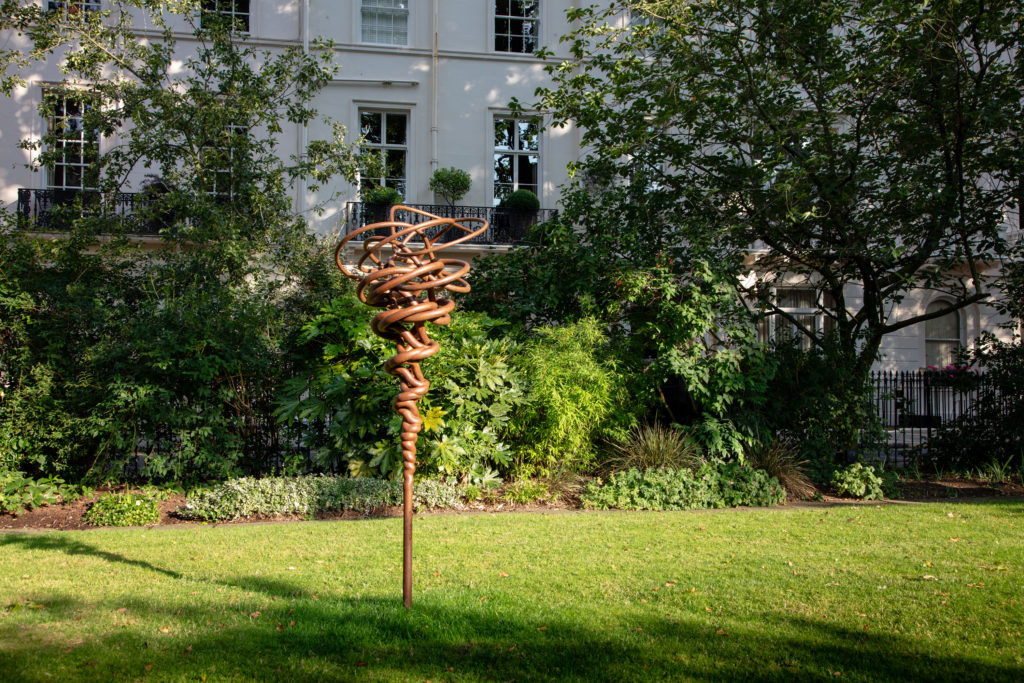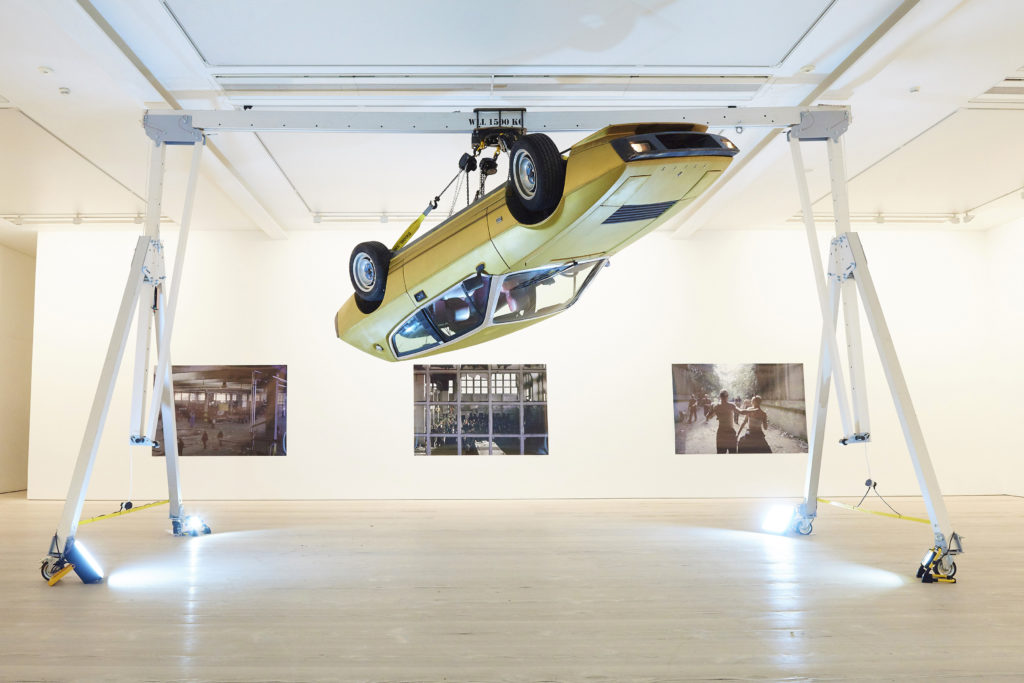[ad_1]
Conrad Shawcross’s art points out, gently but firmly, the fallibility of cerebral disciplines. Science and math, in Shawcross’s empathetic work, are shown to be human and flawed. Limen 72.9, a sculptural installation from his 2000 MFA show at Slade School of Fine Art in London, was a capsized boat topped with an oversized cage which his recent Instagram caption described as representing “the lifelong search for a beast that in the end overpowers you.”
Later works recreate failed machines, and his recent series of sculptures, collectively inspired by Thomas Kuhn’s 1962 The Structure of Scientific Revolutions, were designed to represent the birth and limitations of paradigm shifts. As Shawcross’s interlocking tetrahedrons demonstrate through their apparently gravity defying forms and delicate splintering, like a flame fizzling out, the rational and seemingly objective foundations for our relationship with the world are disarmingly fragile—magical, even—and subject to trends.
In Golden Lotus (Inverted), Shawcross’s current installation at the Saatchi Gallery in London, he silences his cerebrum to create a tribute to renegade raves’ pure emotional release. As his contribution to the exhibition “Sweet Harmony: Rave / Today,” he hung a disemboweled, gold Capri Lotus Elite upside down from the ceiling. Shawcross’s car spins around to a bespoke soundtrack by DJ Mylo (Myles MacInnes). The exhibition, which was curated by Philly Adams and Kobi Prempeh and runs through September 14, celebrates Acid House’s significance and its infectious, defiant, bliss.
While in London this summer, I stopped into Shawcross’s Clapton studio, where I attended unforgettably fun parties in the early 2000s that involved aerial acrobats dangling in a hole between floors. The studio is less feral today, although Eros, his Russian Blue, was on hand, napping and chatting throughout our—long-overdue—catch-up.

Shawcross.
MARC WILMOT
Ana Finel Honigman: I was surprised that your work is in “Sweet Harmony” because I don’t think of you having any connection with rave culture. Rave’s radical optimism is almost anathema to my image of your work’s core perspective.
Conrad Shawcross: You’re right it is very different from my work. My work is very scientific and rational but having the car there, spinning around, is a gesture that comes from my heart rather than my head. I have a personal connection to it because I experienced it and enjoyed it when I was younger. I have a love of it, from a personal perspective. I traveled with a sound system called Desert Storm through Eastern Europe when I was 18. It is normally not very personal or subjective. It is not linked to it, but I was asked to be part of the show. Actually, it came about through a series of accidents and coincidences, which was nice.
AFH: How so?
CS: Kobi, who is a friend of mine, is a DJ and co-curator of the show. He met Philly at my 40th and became friends. They decided to do this show. She texted me on a Friday and asked whether they could use my car, the Capri, in a show about rave culture. I got very excited and spent the weekend sketching what I wanted to do. When she called back she explained they wanted the car. She wanted to use the Capri because, apparently, everyone went to raves in a Capri. I asked whether they didn’t want to have an amazing installation because I had designed hanging it upside down and spinning it around. And she, “Oh no, we don’t want to do that,” but she could hear the disappointment in my voice. She said, “Oh, okay, if you really want to do it.” I said, “Thank you!”
Did you just have a car laying around?
I had this car in a field. It was a car that I genuinely owned. It stopped working ages ago. I had a love/hate relationship with it because it never really worked properly. But, for this, it works. The industrial nature of it and that kind of subversion of it. It is anarchic and playful. There is that youthful gesture. It is part of that scene. It is like a factory. I said, “Let’s turn this tunnel into a party,” let’s appropriate something and turn it into something else. It’s a part of that whole scene. I love the car from a sculptural point of view. It has this amazing shape and body but it never should have hit the streets.
It’s a long, lean…
It’s fiberglass and gold.
It looks like a toy. It looks like a prize in a 1980s cereal box.
The car is called a Lotus Elite and it was built in the ‘80s. In some ways, it doesn’t quite fit to have this sportscar hung upside down, but there is a sense that it’s been stolen from a rich fat cat and hung upside down. There is that punk element. It isn’t meant to be a celebration of some lush lifestyle.
Elite, literally turned upside down.
The name is so problematic in itself. That ‘80s name for a car is seeping in problems of class and snobbism. We are so suspicious of elites nowadays. The right-wing elites and the left-ring elites are so suspicious of each other—all these conspiracy theories right now. We believe they are controlling our destinies. It is quite a loaded name for a car.
Deconstructing the name brings this closer to my understanding of your work. When I think of your art, I think of something darker and more existential or ontological. The radical joy of rave culture doesn’t connect, but the crash afterwards might. That Pulp “Sorted Out for Es and Wizz” sensibility…
There is that whole failed technology and all that.
Knowing the car literally failed on you helps.
I wanted to turn it upside down and make it spin around for ages. I can’t really justify it, in a way. And we designed it ourselves, to make it literally spin. To have built it and conceived it was actually quite easy after years of toil building mechanical machines. It was easy, as a thing. I had the car and it was sitting in a field, just growing moss, because it’s fiberglass. It was repulsive, but I wanted to do it.

Conrad Shawcross, Formation II (The Dappled Light of the Sun), 2015, currently on view at Wilton Crescent in London.
COURTESY THE ARTIST, VICTORIA MIRO, LONDON AND VENICE/PHOTOGRAPH BY RICHARD IVEY
When did the significance of the gesture start making larger sense to you?
It wasn’t important to know what it meant when I started to do it. It’s not so important to know what something means when you do it, but then the larger sense of it starts coming together and that’s very exciting.
It fits.
All the connotations and meanings that I’ve described are very valid and fit. It also fits in an interesting way into the show. A Ford Fiesta or Mini would mean something else, or would it? This Capri is a very particular shape, and there are only three of them left. They were so unsuccessful. They were so niche. They are not worth anything. They are very rare. Only 30 were made at the time but only three remain, yet they’re worthless. I stripped its engine and there are only two in the world.
Maybe they’ll breed. Noah’s Ark. You only need two.
I don’t think anyone wants them but maybe they might now that one is art. Now that it’s an artwork, it’s worth more than a car.
It is an iconic shape. It looks like a child drew a car. The color is such a part of it. Humans just like gold. We should, maybe, be more mindful of its connotations but it’s an inherently appealing thing.
And it’s an ‘80s paint job, so it’s quite tarnished. It’s messed up. It’s not bright. It is what it is. The music is Mylo. We locked ourselves inside the car and I found a tape I made from 1995. We rotated around in the car, sitting on the roof. We were upside down in the car, just spinning around.
So you have no natural predilection for anxiety, whatsoever. You’re just not wired that way?
Not at all. I was fine. Mylo got overexcited, not claustrophobic, and smashed the window.
Is this the end of the car’s journey?
I would like other musicians to come up with tracks for the car.
Back to what I was saying about this work feeling like a significant departure—when you first started showing work, it felt more critical, even skeptical, than the culture, but society has caught up with your concerns about technology and science. It seems like you were sounding an alarm by reminding us of progress’s fallibility. Do you feel that your work’s worldview, your skepticism, is more normalized now?
Things are accelerating at such an extraordinary rate. The integration of technology is terrifying. I have a son now and he’s five. I remember my mum marveling at the way I could learn to write and speak. She found it extraordinary, but when I am teaching my son to read and do mathematics, I just have this anxiety about how slow humans’ processing is compared to technology. The way we can sync things to the internet and everything can be transferred so immediately is really frightening. It is not necessarily intelligence, but we are so slow compared to how quickly AI can learn. That is truly frightening. It is the post-humanism. Instead [I should be] marveling at my son as a miracle of human consciousness, and understand that he’s not slower than any other kid, he is brilliant—but the way we learn is so slow compared to technology. When I grew up, it was still the age of humanism and we were this positive force for good but now … we can only see ourselves as a plague. We are a blight on nature, but we are also going to be replaced by a thing we’ve created.

Conrad Shawcross, Manifold 5:4, 2016, currently on view at Wilton Crescent in London.
COURTESY THE ARTIST, VICTORIA MIRO, LONDON AND VENICE/PHOTOGRAPH BY RICHARD IVEY
That is so true. Even on the most intimate levels that we think can’t be automated out. I’m doing a master’s degree in mental health counseling now and all the techniques we are learning—reflective listening, open questions, limiting our facial expressions and any register of subjectivity as toxic counter-transference—acknowledges that our humanity is actually a hindrance to affective healing. I keeping thinking about Eliza, the automated therapist Joseph Weizenbaum designed at MIT in 1964. She was early AI and did everything I am being trained to do, while doing nothing I struggle to keep myself from doing in my practice sessions or field work. People suffering preferred her to a human despite all the official literature stressing the importance of human connection to effective therapy. Having said that, dogs make better therapists than humans or computers! This does relate, for me, to your work dismantling utopian fantasies and fallacies.
Definitely. The Paradigm sculptures are called paradigm because they represent paradigm shifts. These tendrils that rise up are about an argument getting stronger and stronger as it rises, but at the same time getting increasingly precarious. As ideas progress, they can be challenged and topple. You have to undermine or chip away at the status quo and topple existing ideas of what is true, if you can, to see what can succeed. Progress is the process of disproving something.
What would your ideal future look like? Is the end goal getting to peace and calm, or is struggle part of paradise?
Stopping struggle is the end of progress. Look at #MeToo. Even watching a film from five years ago just looks so unacceptable. The way we’ve all woken up, although I as a man might have been less aware of injustice, is still incredible. We were all in an unfair reality and a lot of people, including women, thought it was fine, but the veil was lifted.
It’s interesting how, in our era, people would just say “that’s really fucked up,” as both validation and resignation, when boundaries were violated and injustices occurred. That was the phrase to sign and shrug it off as inevitable, whereas this generation isn’t accepting those realities and is fighting for complete structural, not only perceptual, change. The Gen X world-weariness now looks like it wasn’t sophistication but apathy and hopelessness. We knew what was wrong but we didn’t know anything could be done about it.
Is it a generational thing or just the zeitgeist?
This is a massive sweeping generalization but, since you asked, I think it’s largely generational. Whether we knew it, or not, I think we were all sickened by Jerry Rubin’s transformation from Yippie to Yuppie and the toxic, self-serving self-centeredness of the Baby Boomers, because hippies had the right ideas about structural change. Cynicism and irony were our fundamental, reactionary responses to the world and that stance turned maladaptive, by and large, but people in their 20s are picking up the fights from the ‘60s and ‘70s without that baggage and pushing them forward. I have the most profound respect for people in their teens and 20s today.
That’s the power of youth. When you don’t have so much skin the game, you can really invest in making changes. You’re not supporting a family. You can be fresh and effective. Going back to the whole rave thing, it feels sort of pathetic compared to the activism going on now. When you’re 18, you want to find what defines you. You want a moment. I was caught up in these protests in London called Reclaim the Streets—it was an anarchic movement. I was caught up in the idea of an anti-establishment, counter-culture movement, but it was, actually, not very meaningful or noble. It was catalytic, indulgent, and bohemian and loads of fun, but it wasn’t like a movement now. If I were 20 years younger, I would be caught up in all this and railing for it, doing everything I could, and actually defining myself by that. And I am so jealous of people seeing clearly what needs to happen and has to happen. Just as the ‘60s changed our ideas about reality and what we wanted from society. The rave counterculture didn’t change a whole lot, although Jeremy Deller’s documentary Everybody in the Place: An Incomplete History of Britain 1984-1992 shows that it wasn’t exclusively trivial.
How did Acid House change British culture?
There was a purity to it. I felt on a journey. The music was very pure and minimalist. There were three-dimensional spaces sculpted by sound. It was quite tragic, in some ways, because it became more and more purist until it could no longer be. It became Gabber, which were these tonally awful, aggressive sound systems. I was with Desert Storm, who were very critical of all other music as an insult to their puritanical situation. They sounded like machine gun fire for 6 hours.
You mentioned earlier that this is an unusually personal artwork for you. Is this the first work of yours that you can look at and recognize that you’re transitioning into a new and other life phase?
Do you mean, is this a midlife crisis?
Does it have to be a crisis? You can transition smoothly and gracefully. Even gratefully.
I don’t know. I really enjoyed doing it. I felt real pleasure from it. I was thinking of doing a whole massive piece of cars. Maybe a constellation of Lotuses. If this became all that I do, maybe that is a crisis. It’s made me laugh and smile. It’s a spontaneous thing. It’s a joy.
[ad_2]
Source link

